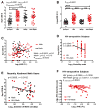Independent and co-morbid HIV infection and Meth use disorders on oxidative stress markers in the cerebrospinal fluid and depressive symptoms
- PMID: 25575491
- PMCID: PMC4900457
- DOI: 10.1007/s11481-014-9581-x
Independent and co-morbid HIV infection and Meth use disorders on oxidative stress markers in the cerebrospinal fluid and depressive symptoms
Abstract
Both HIV infection and Methamphetamine (Meth) use disorders are associated with greater depressive symptoms and oxidative stress; whether the two conditions would show additive or interactive effects on the severity of depressive symptoms, and whether this is related to the level of oxidative stress in the CNS is unknown. 123 participants were evaluated, which included 41 HIV-seronegative subjects without substance use disorders (Control), 25 with recent (<6 months) moderate to severe Meth use disorders (Meth), 34 HIV-seropositive subjects without substance use disorders (HIV) and 23 HIV+Meth subjects. Depressive symptoms were assessed with the Center for Epidemiologic Studies-Depression Scale (CES-D), and oxidative stress markers were evaluated with glutathione (GSH), 4-hydroxynonenal (HNE), and activities of gamma-glutamyltransferase (GGT) and glutathione peroxidase (GPx) in the cerebrospinal fluid (CSF). Compared with Controls, HIV subjects had higher levels of HNE (+350%) and GGT (+27%), and lower level of GSH (-34%), while Meth users had higher levels of GPx activity (+23%) and GSH (+30 %). GGT correlated with GPx, and with age, across all subjects (p < 0.0001). CES-D scores correlated with CSF HNE levels only in Control and HIV groups, but not in Meth and HIV+Meth groups. HIV and Meth use had an interactive effects on depressive symptoms, but did not show additive or interactive effects on oxidative stress. The differential relationship between depressive symptoms and oxidative stress response amongst the four groups suggest that depressive symptoms in these groups are mediated through different mechanisms which are not always related to oxidative stress.
Conflict of interest statement
Figures




References
-
- Aukrust P, Muller F, Svardal AM, Ueland T, Berge RK, Froland SS. Disturbed glutathione metabolism and decreased antioxidant levels in human immunodeficiency virus-infected patients during highly active antiretroviral therapy–potential immunomodulatory effects of antioxidants. J Infect Dis. 2003;188:232–238. - PubMed
-
- Awodele O, Olayemi SO, Nwite JA, Adeyemo TA. Investigation of the levels of oxidative stress parameters in HIV and HIV-TB co-infected patients. J Infect Dev Ctries. 2012;6:79–85. - PubMed
Publication types
MeSH terms
Substances
Grants and funding
- G12 MD007601/MD/NIMHD NIH HHS/United States
- U54NS56883/NS/NINDS NIH HHS/United States
- 5G12RR003061/RR/NCRR NIH HHS/United States
- U54 MD007584/MD/NIMHD NIH HHS/United States
- R24 DA027318/DA/NIDA NIH HHS/United States
- 2K24DA016170/DA/NIDA NIH HHS/United States
- P20 RR016467/RR/NCRR NIH HHS/United States
- G12 RR003061/RR/NCRR NIH HHS/United States
- 2R24DA027318/DA/NIDA NIH HHS/United States
- 8G12MD007601/MD/NIMHD NIH HHS/United States
- 5P20RR016467-11/RR/NCRR NIH HHS/United States
- K24 DA016170/DA/NIDA NIH HHS/United States
- U54 NS056883/NS/NINDS NIH HHS/United States
LinkOut - more resources
Full Text Sources
Other Literature Sources
Medical
Miscellaneous

